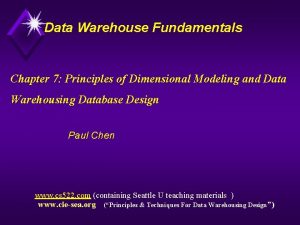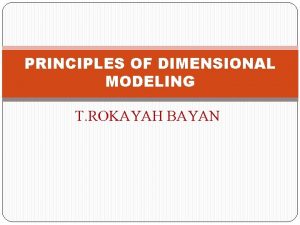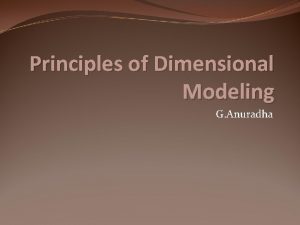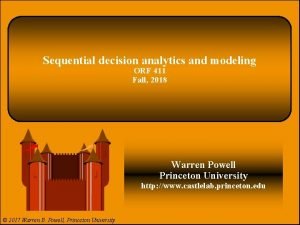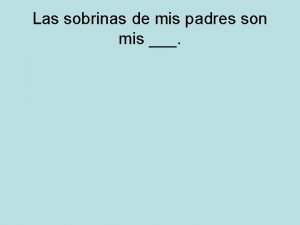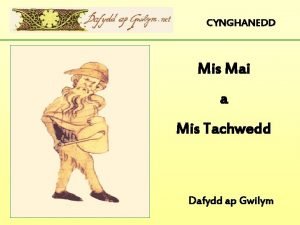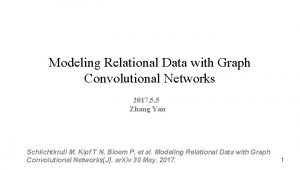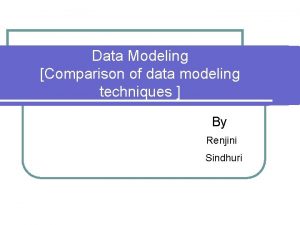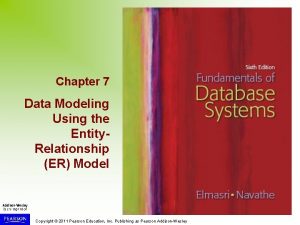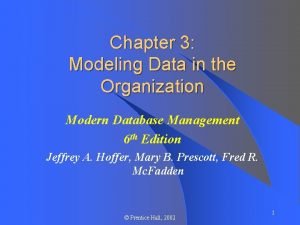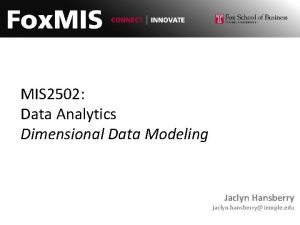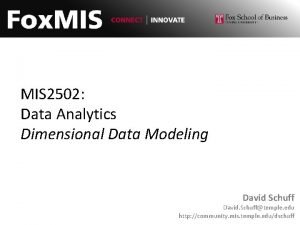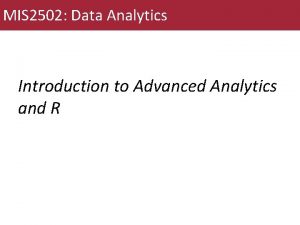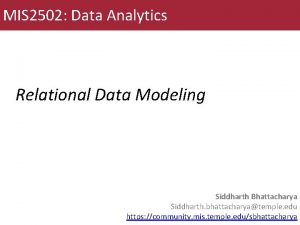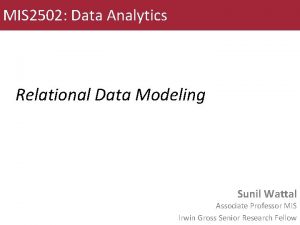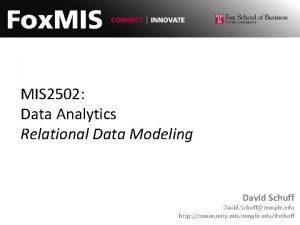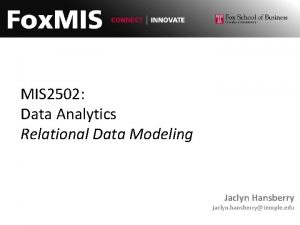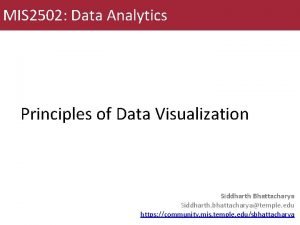MIS 2502 Data Analytics Dimensional Data Modeling Where





















- Slides: 21

MIS 2502: Data Analytics Dimensional Data Modeling

Where we are… Now we’re here… Data entry Data extraction Transactional Database Stores real-time transactional data Data analysis Analytical Data Stores historical transactional and summary data

What do we know so far? Why are relational databases good for storing transaction data? Why are they bad for analytical processing? What’s the solution?

Some terminology Data Warehouse • Takes many forms • Really is just a repository for data Data Mart • More focused • Specially designed for analysis Data Cube • Organization of data as a “multidimensional matrix” • Implementation of a Data Mart

How they all relate The data in the operational database… …is put into a data warehouse… …which feeds the data mart… …and is analyzed as a cube. We’ll start here.

The Data Cube M&Ms Store • Core component of Online Analytical Processing and Multidimensional Data Analysis • Made up of “facts” and “dimensions” Product Diet Coke Doritos Ardmore, PA quantity & total price Temple Main quantity & total price quantity & total price Cherry Hill, NJ Famous Amos Mar. 2013 King of Prussia, PA quantity & total price Quantity sold and total price are measured facts. Why isn’t product price a measured fact? Feb. 2013 Jan. 2013 Ti m e

Cube Terminology Fact Dimension Central values that are analyzed An organization of categories that describe the facts in the cube Usually numeric and calculated Typically describe the information on which the user wants to base their analysis Stored based on the user’s needs

The Data Cube Product M&Ms A single summary record representing a business event (monthly sales). Store The highlighted element represents all the M&Ms sold in Ardmore, PA in January, 2011 Diet Coke Doritos Ardmore, PA quantity & total price Temple Main quantity & total price quantity & total price Cherry Hill, NJ Famous Amos Mar. 2013 King of Prussia, PA quantity & total price Feb. 2013 Jan. 2013 Ti m e

The Data Cube Product The highlighted elements represent Famous Amos cookies sold on Temple’s Main campus from January to March, 2013 This is called “slicing the data. ” Store M&Ms Diet Coke Doritos Ardmore, PA quantity & total price Temple Main quantity & total price quantity & total price Cherry Hill, NJ Famous Amos Mar. 2013 King of Prussia, PA quantity & total price Feb. 2013 Jan. 2013 m i T e

The Data Cube Product M&Ms Store What do the orange highlighted elements represent? What do the purple highlighted elements represent? Diet Coke Doritos Ardmore, PA quantity & total price Temple Main quantity & total price quantity & total price Cherry Hill, NJ Famous Amos Mar. 2013 King of Prussia, PA quantity & total price Feb. 2013 Jan. 2013 m i T e

Could you have a data mart with five dimensions? Then why does our example (and most others) only have three?

Dimension Modeling a data cube: The Star Schema Store_ID Store_Address Store_City Store_State Store_Type Transactional databases aren’t built around dimensions So we build a star schema The star schema facilitates • Aggregating individual transactions • Creation of cubes Dimension • Built around “dimensions” and “facts” • Simplified relational model Product_ID Product_Name Product_Price Product_Weight Sales_ID Product_ID Store_ID Time_ID Quantity Sold Total Price Dimension Fact • They don’t map well to cubes • They aren’t set up for summarization Time_ID Day Month Year

A join to make the cube? Conceptually yes, but storing the join would create many, many rows! Sales ID Qty. Sold Total Price Prod. ID Prod. Name Prod. Price Prod. Weight Store ID Store Address Store City Store State Store Type Time ID Day Month Year 1000 1001 1002 Sales Fact Product Dimension Store Dimension Time Dimension

So summaries get stored in a “multidimensional matrix” Periodically summarize the data and store it in the cube Retrieve only the summary, not the raw data Much more efficient, but can’t be changed (non-volatile)

It adds up fast… 1000 products 300 stores 365 days =109, 500, 000 records per year!

Designing the Star Schema Kimball’s Four Step Process for Data Cube Design (Kimball et al. , 2008) 1. Choose the business process 2. Identify the fact 3. Decide on the level of granularity 4. Identify the dimensions

Choose the business process • What your data cube is “about” • Determined by the questions you want to answer about your organization Question Business Process Who is my best customer? Sales What are my highest selling products? Sales Which teachers have the best student performance? Standardized testing Which supplier is offering us the best deals? Purchasing Note that a “business process” is not always about business.

Identify the fact The data associated with the business event Keys Measured, numeric data • Unique identifiers for each event • For the event itself and the associated dimensions • Quantifiable information for each business event • Does not describe any particular dimension • Associates a combination of the dimensions to a unique business event • Example: Sales has Product_ID, Store_ID, and Time_ID • Describes a particular combination of dimensional data • Example: Sales has quantity_sold and total_price. Try it for the “student performance” example.

Decide on the level of granularity • Level of detail for each event (row in the table) • Will determine the data in the dimensions • Example: Who is my best customer? – The “event” is a sales transaction – Choices for time: yearly, quarterly, monthly, daily – Choices for store: store, city, state How would you select the right granularity?

Identify the dimensions • The key elements of the process needed to answer the question (“fact”) • Example: Sales transaction – A “sale” is the fact – Occurs for a particular product, store, and time – Could this data mart tell you • The best selling product? • The best customer? Try it for the “student performance” example.

Data cube caveats • The cube is “non volatile, ” so you’re locked in – Measured facts – Dimensions – Granularity • So choose wisely! – For example: You can’t track daily sales if “date” is monthly – So why not include every single sale and do no aggregation? “In memory” analytics is changing all of this, but not quite yet…
 Relational vs dimensional data modeling
Relational vs dimensional data modeling Texto descriptivo estructura
Texto descriptivo estructura Afi 36 2502
Afi 36 2502 A circular motion is one dimensional
A circular motion is one dimensional Principles of dimensional modeling
Principles of dimensional modeling Degenerate dimensions
Degenerate dimensions Factless fact table
Factless fact table Dimensional modeling basics
Dimensional modeling basics Helen c. erickson nursing theory
Helen c. erickson nursing theory Sequential decision analytics
Sequential decision analytics Teramond
Teramond Misión proyecto de vida
Misión proyecto de vida El hijo de mi tío es mi ___.
El hijo de mi tío es mi ___. Mis mai a mis tachwedd
Mis mai a mis tachwedd Mis mai a mis tachwedd
Mis mai a mis tachwedd Mis actos son un reflejo de mis creencias
Mis actos son un reflejo de mis creencias Data modeling best practices for data warehousing
Data modeling best practices for data warehousing Modeling relational data with graph convolutional networks
Modeling relational data with graph convolutional networks Data modeling techniques
Data modeling techniques Data modeling using entity relationship model
Data modeling using entity relationship model Data warehouse modeling tutorial
Data warehouse modeling tutorial Modeling data in the organization
Modeling data in the organization




